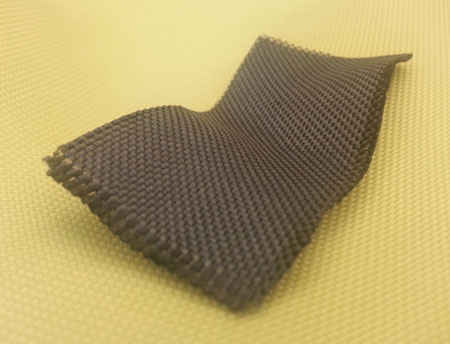| Posted: Oct 31, 2014 | |
Tough electronics based on ALD-coated Kevlar |
|
| (Nanowerk News) A group of North Carolina State University researchers is exploring novel ways to apply semiconductor industry processes to unique substrates, such as textiles and fabrics, to "weave together" multifunctional materials with distinct capabilities. | |
|
During the AVS 61st International Symposium & Exhibition, being held November 9-14, 2014, in Baltimore, Maryland, the researchers will describe how they were able to "weave" high-strength, highly conductive yarns made of tungsten metal on Kevlar -- aka body armor material -- by using atomic layer deposition (ALD), a process commonly used for producing memory and logic devices. "As a substrate, Kevlar was intriguing to us because it's capable of withstanding the relatively high temperature (220°C) required by the ALD deposition process," explains Sarah Atanasov, a Ph.D. candidate in the Biomolecular Engineering Department at North Carolina State University. "Kevlar doesn't begin to degrade until it reaches nearly 400°C." The group selected ALD as a process because it allows them to deposit highly conformal films on nonplanar surfaces with nanometer-thickness precision. "This ensures that the entire surface of the yarn -- made of nearly 600 fibers, each 12 microns in diameter -- is evenly coated," said Atanasov. |
|
| How does the ALD process work? It's actually a cyclical process, which begins by exposing the substrate's surface to one gas-phase chemical, in this case tungsten hexafluoride (WF6), followed by removal of any unreacted material. This is chased with surface exposure to a second gas-phase chemical, silane (SiH4), after which any unreacted material is once again removed. | |
| By the end of the ALD cycle, the two chemicals have reacted to produce tungsten. "This is a self-limited process, meaning that a single atomic layer is deposited during each cycle -- in this case ~5.5 Angstroms per cycle," Atanasov said. "The process can be cycled through a number of times to achieve any specifically desired thickness. As a bonus, ALD occurs in the gas phase, so it doesn't require any solution processing and is considered to be a more sustainable deposition technique." | |
| While weaving together multiple fabrics to combine multiple capabilities certainly isn't new, characteristics such as high strength, high conductivity, and flexibility are frequently regarded as being mutually exclusive -- so concessions are often made to get the most important one. | |
 |
|
| Tungsten-coated Kevlar with a Kevlar (uncoated) background. | |
| The work by Atanasov and colleagues shows, however, that ALD of tungsten on Kevlar yields yarns that are highly flexible and highly conductive, around 2,000 S/cm ("Siemens per centimeter," a common unit used for conductivity). The yards are also within 90 percent of their original prior-to-coating tensile strength. | |
| "Introducing well-established processes from one area into a completely new field can lead to some very interesting and useful results," Atanasov noted. | |
| The group's tungsten-on-Kevlar yarns are expected to find applications in multifunctional protective electronics materials for electromagnetic shielding and communications, as well as erosion-resistant antistatic fabrics for space and automated technologies. | |
| Presentation #MS+PS+TF-ThA4, "Multifunctional Fabrics via Tungsten ALD on Kevlar," authored by Sarah Atanasov, B. Kalanyan and G.N. Parsons, will be at 3:20 p.m. ET on Thursday, Nov. 13, 2014. |
| Source: AVS |
